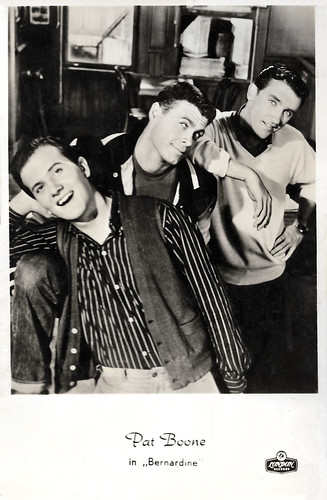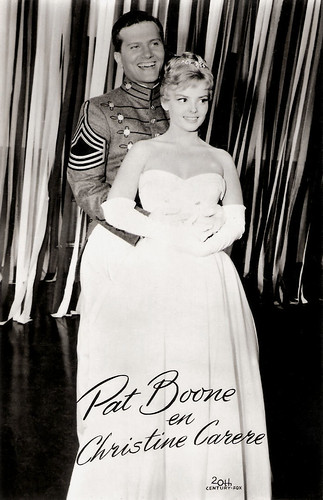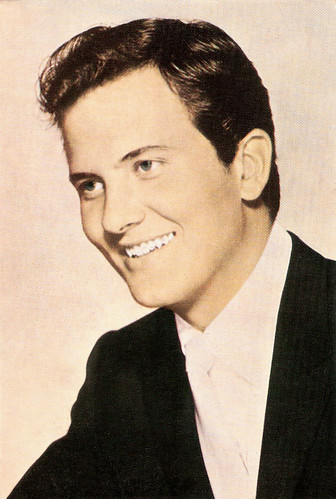
Dutch postcard by Uitgeverij Takken, Utrecht, no. AX 4211. Photo: 20th Century Fox.

Dutch postcard by Gebr. Spanjersberg N.V., no. 5008. Photo: London. Pat Boone, Val Benedict, and Ronnie Burns in Bernardine (Henry Levin, 1957).

Dutch postcard by Uitgeverij Takken, Utrecht, no. AX 3845. Photo: 20th Century Fox. Christine Carère and Pat Boone in Mardi Gras (Edmund Goulding, 1958).
Polishing rhythm-and-blues hits into more accessible versions
Charles Eugene Patrick (Pat) Boone was born in Jacksonville, Florida, in 1934. His father, Archie Altman Boone, was a building contractor and his mother, Margaret Virginia (née Pritchard), was a nurse. His younger brother, Nick Boone, also had a popular music career under the name Nick Todd.
Pat grew up in Nashville, Tennessee, and attended David Lipscombe College, North Texas State College, and Columbia University from which he received a Bachelor of Science degree in 1958. Boone began his career by performing in Nashville's Centennial Park and started recording for Republic Records in 1954.
In 1955 he released a cover of the single 'Ain't That a Shame' by Fats Domino, and significantly broke the sales records of the original version. A number-one single in 1956 by Boone was a second cover and a revival of a then seven-year-old song 'I Almost Lost My Mind', by Ivory Joe Hunter, which was originally covered by another black star, Nat King Cole.
It is representative of the early period of Boone's career, which mainly focused on polishing rhythm-and-blues hits into more accessible versions, allowing the Rock and Roll tunes to reach a much wider audience. Boone was also criticised for his homogenised, sanitized versions. He succeeded in removing all of the more suggestive lyrics from his cover of Little Richard's 'Long Tall Sally'. He changed the original's, "I saw Uncle John with Long Tall Sally, He saw Aunt Mary comin' and he ducked back in the alley" to, "Long Tall Sally's got a lot on the ball,/And nobody cares if she's long and tall." However, Little Richard himself once said: "It was Pat Boone who made me a millionaire".
Boone had the image of a fresh-faced smooth guy, who appealed to both teenagers and their parents. His singing style, a full baritone, followed in the footsteps of his idol Bing Crosby. Soon he switched more and more to singing ballads. At the end of the 1950s, Pat Boone was only surpassed in popularity by Elvis Presley. And just like Elvis, he made an attempt at some acting.
Although he made considerably fewer films than Elvis, it is said that his films were of considerably higher quality. Several film studios pursued him and he decided to go with 20th Century Fox, which had made Elvis Presley's first film. Fox reworked the play 'Bernardine' into a vehicle for Boone. The resulting film, Bernardine (Henry Levin, 1957), with Terry Moore and Janet Gaynor, was a solid hit, earning $3.75 million in the US.
His recording for the title song of his second film, April Love (Henry Levin, 1957), in which he co-starred with Shirley Jones, was nominated for an Oscar. At the age of 23, he began hosting a half-hour ABC variety television series, The Pat Boone Chevy Showroom, which aired for 115 episodes (1957–1960).
His recording of 'A Wonderful Time Up There' in 1958 became the first million-selling record with religious lyrics. Seeing himself as a devout born-again Christian, he refused music and film roles that went against his moral standards, including roles with the then-sex symbol Marilyn Monroe. In each of his film contracts, there was a term specifying that kissing his partner could not be forced on him by the director due to his religious convictions.
Less popular was the musical comedy Mardi Gras (Edmund Goulding, 1958) with Christine Carère. However, the Science-Fiction adventure, Journey to the Center of the Earth (Henri Levin, 1959), with James Mason and Arlene Dahl, was a huge hit.

German postcard by Krüger, no. 902/262. Photo: Ann-Margret and Pat Boone in State Fair (José Ferrer, 1962).

Spanish postcard by Postal Oscarcolor, no. 100, 1964.

German postcard by Krüger, no. 902/64.
The end of Boone's career as a hit machine
Pat Boone wrote the lyrics for the title song for the film Exodus (Otto Preminger, 1960), which he titled 'This Land Is Mine'. He produced and starred in a documentary, Salute to the Teenagers (1960), but did not make a film for a while, studying acting with Sanford Meisner.
He returned with a military comedy, All Hands on Deck (Norman Taurog, 1961), a mild hit. He starred opposite Bobby Darin and Ann-Margret in another remake, State Fair (José Ferrer, 1962), but it was another box office disappointment. Musicals were becoming less fashionable in Hollywood.
An invasion of British pop groups such as The Rolling Stones, The Beatles, and The Kinks ended Pat Boone's career as a hit machine, although he continued to make records in the 1960s. During the early 1960s, Boone starred in a handful of British films, produced by his own Cooga Mooga productions. In one of these, The Yellow Canary (Buzz Kulik, 1963), he attempted to shake up his established image by portraying a nasty, ill-tempered rock star.
In the 1960s, he also began writing self-help books for adolescents, including the best-seller 'Twixt Twelve and Twenty'. In the 1970s, he switched to gospel music and country and continued to perform in other media, especially radio. Later, he was a disc jockey for a popular American old-time radio station and ran his own record company, which re-releases records from the 1950s that no longer have a place on major record labels.
Boone married Shirley Lee Foley in 1953 and they had four daughters: Cherry, Lindy, Debby, and Laury. In the 1960s and 1970s, the family toured as gospel artists and made gospel albums such as 'The Pat Boone Family' and 'The Family Who Prays'.
In 1997, Boone released an album entitled 'No More Mr. Nice Guy', which featured a collection of heavy metal covers polished to fit the Pat Boone style. To advertise the album, he appeared at the American Music Awards ceremony in black leather. He lost his respectable image in one fell swoop, at least among large sections of his following among conservative Christians. Because of this action, he was fired from Gospel America, a television programme of the Trinity Broadcasting Network.
However, the music from this CD was often used during the intermission of hard rock and heavy metal concerts, and the CD was appreciated by the somewhat older guard of hard rockers who saw the humour in it and could appreciate the performance of the songs, which included a choir and a full orchestra. In 2003, his gospel recordings were recognised by Nashville's Gospel Music Association and added to the Gospel Music Hall of Fame.
Boone lived in Los Angeles for many years with his wife Shirley Foley. They were influential members of the 'Church on the Road', the Inglewood Church of Christ in San Fernando Valley. Shirley (84) passed away in January 2019, when they had been married for 65 years.

Dutch postcard by Uitgeverij Takken, Utrecht, no. AX 3313. Photo: 20th Century Fox. Pat Boone in Bernardine (Henry Levin, 1957).

Dutch postcard by Uitgeverij Takken, Utrecht, no. AX 3843. Photo: 20th Century Fox. Christine Carère and Pat Boone in Mardi Gras (Edmund Goulding, 1958).

Dutch postcard by Uitgeverij Takken, Utrecht, no. AX 4213. Photo: 20th Century Fox. Pat Boone in Journey to the Center of the Earth (Henri Levin, 1959).

Dutch postcard. Sent by mail in 1964.
Sources: Hal Erickson (AllMovie), Wikipedia (Dutch and English), and IMDb.
No comments:
Post a Comment